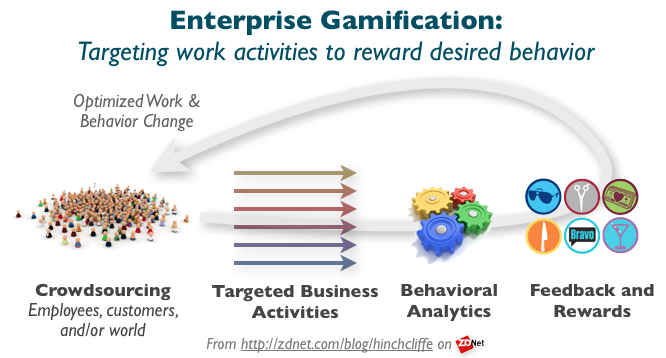Enterprise gamification: Will it drive better business performance?

Gamification has the potential to greatly optimize the way humans are connected to and go about their work. Like social media, and usually closely integrated with it, gamification is an emerging new field that's still difficult to broach in many management circles because of its perception that it's not an appropriate or serious enough business topic. Yet a growing number of impressive outcomes as well as a burgeoning set of supporting tools and technologies are making it increasingly likely that gamification will find its way into a workplace near you over the next couple of years.
In fact, as enterprise platforms -- particularly internal social networks -- open up to embedded third party applications (such as OpenSocial) and business applications themselves add gaming features, the decision point on whether to apply gamification strategically is approaching for many organizations.
On its face the case for gamification, which is defined here as adding game-like activities to improve non-game contexts, is a strong one and easy to state. Namely, if properly situated in business processes, the incorporation of game features in work activities can reward desired behavior, create more intensively participative processes, track group progress, establish feedback loops that reinforce and accelerate sought after business outcomes, and more. Why does gamification do this? The belief is that it taps directly into the cognitive and psychological predispositions of humans to engage in game-like behavior that they find interesting, engaging, and rewarding. And fun.
But fun isn't something that's generally regarded as very important in the workplace. However, meeting deadlines, accomplishing objectives, overcoming and solving important challenges are widely valued by businesses. Yet that's precisely where gamification and work overlap. The reality is that a lot of modern careers, particularly those in the service industry and knowledge work, often consist of repetitive drudgery -- filled with seemingly endless routine tasks and rote processes -- that can sap the motivation of even the most well-intentioned employee. The premise then is what if such tasks, which are often at the very center of what a company needs in order to operate and compete, could be made more productive and efficient by making them more engaging to the humans that use them?
A combination of design thinking, which is rooted in empathy for the context of a problem, and user-centered design, a philosophy and process in which the wants, needs, and limitations of end users allow for the creation of more effective products, gamification has the potential to greatly optimize the way humans are connected to and go about their work. In other words, if you want work to get done in the best possible way, then it should be designed for the way humans actually work best.
So, in the consumer world, games have long been designed to enthrall and captivate their users for as long possible, providing loosely structured encouragement to reach new heights and achieve intensive, team-based cooperative objectives with a single-mindedness and purpose that all-to-often missing entirely in garden-variety business processes. We are just now fully beginning to realize it's now both 1) possible to achieve and 2) an increasingly well understood discipline to design business processes in the same way.
Hard hitting results
\Over the last few years, the gamification industry has been building up an impressive string of wins that are becoming hard to ignore. Long-standing problems in science and industry are beginning to fall as gamification is aimed at previously difficult to solve and otherwise highly stubborn problems. Just couple of months ago, Scientific American reported that online gamershad achieved the first crowdsourced redesign of a protein, and one that is commercially useful in many vital industrial processes, ultimately resulting in an eye-opening 18-fold improvement in outcome. In another example, The Wall Street Journal recently explored how a call center was able to reduce wait times up to 15% and increase sales by up to 12% using gamification. Numerous other examples exist. These are significant achievements that by themselves -- using non-game approaches-- experts often have great difficulty reproducing.
Related: Made on the Web, designed by us.
How gamification works is important and uses processes that been understood since the start of the Web 2.0 era. In particular, crowdsourcing can be a particularly important element of successful gamification. By cost-effectively enlisting peer production and mass collaboration to rapidly creating a large group of players, who are then driven towards the desired objective through an architecture of participation that has gaming features used to improve the rate and length of engagement. Although gamification can be successful without crowdsourcing, tapping into diverse audience of outsiders increases innovation, scalability, elasticity, and capacity of the gamified business process.
Gamification tools and platforms arrive
Effectively realizing gamification requires the right software and until recently, most gamification efforts have been bespoke efforts involving custom-developed software due of a dearth of enterprise-ready platforms. That is no longer the case, as a combination of startups and established vendors have entered the space.
Here are some of the leading providers of gamification services, platforms, and tools. Note that these companies have offerings that are either 1) explicitly designed for business use or 2) can easily be used by businesses, but may have other uses as well.
 Bunchball. One of first companies to provide game mechanics as a service, Bunchball is one of the most established enterprise gamification players. Offered primarily as a platform that companies can use to integrate into their own intranets, Web sites, and other applications, Bunchball increasingly has off-the-shelf experiences such as the new gamification module for Jive Software's social business platform. Feedback to users includes achievements, status, and rewards. Includes real-time analytics.
Bunchball. One of first companies to provide game mechanics as a service, Bunchball is one of the most established enterprise gamification players. Offered primarily as a platform that companies can use to integrate into their own intranets, Web sites, and other applications, Bunchball increasingly has off-the-shelf experiences such as the new gamification module for Jive Software's social business platform. Feedback to users includes achievements, status, and rewards. Includes real-time analytics. Badgeville. This cloud gamification services combines concepts from from social gaming, traditional loyalty programs and social networking to create what it calls a "behavior lifecycle management solutions." Badgeville offers a portable gaming profile across multiple digital touch points such as company website, mobile applications, online communities, CRM systems, and support desk programs with matching analytics.
Badgeville. This cloud gamification services combines concepts from from social gaming, traditional loyalty programs and social networking to create what it calls a "behavior lifecycle management solutions." Badgeville offers a portable gaming profile across multiple digital touch points such as company website, mobile applications, online communities, CRM systems, and support desk programs with matching analytics. BigDoor. Claiming to have rewarded over 280 million user actions, BigDoor is more customer facing and has a roster of well-known enterprise clients. The service aims at increasing user loyalty and improving engagements levels in existing touchpoints. User received badges, quests, and even tangible rewards to drive participation.
BigDoor. Claiming to have rewarded over 280 million user actions, BigDoor is more customer facing and has a roster of well-known enterprise clients. The service aims at increasing user loyalty and improving engagements levels in existing touchpoints. User received badges, quests, and even tangible rewards to drive participation. Gigya. Gigya's new Game Mechanics platform offers a set of plug-and-play or fully customizable plugins that reward and notify users, drive sought-after behaviors and promote competition within a community site. Gigya's platform allows customers to earn points and rewards for activities like participating in contests, leaving comments, or encouraging others to participate. Users level-up based on their points and their progress can be syndicated out to Facebook and Twitter.
Gigya. Gigya's new Game Mechanics platform offers a set of plug-and-play or fully customizable plugins that reward and notify users, drive sought-after behaviors and promote competition within a community site. Gigya's platform allows customers to earn points and rewards for activities like participating in contests, leaving comments, or encouraging others to participate. Users level-up based on their points and their progress can be syndicated out to Facebook and Twitter. IActionable. Offers a set of gamification services designed explicitly for employees, customers, and other general purpose users, the company's manta is "Measure. Design. Engage. Improve." Now includes out-of-the-box integration with Salesforce.
IActionable. Offers a set of gamification services designed explicitly for employees, customers, and other general purpose users, the company's manta is "Measure. Design. Engage. Improve." Now includes out-of-the-box integration with Salesforce. Punchtab. Designed for a number of turnkey scenarios including loyalty, engagement, and incentivized actions, Punchtab is one of the easiest gamification tools to set up. Primarily focused on external gamification, the service offers badges and achievements and also enables giveaways and other high-value reward mechanisms.
Punchtab. Designed for a number of turnkey scenarios including loyalty, engagement, and incentivized actions, Punchtab is one of the easiest gamification tools to set up. Primarily focused on external gamification, the service offers badges and achievements and also enables giveaways and other high-value reward mechanisms.
It's clearly very early days yet gamification however. Even though management strategy thinkers like John Hagel and John Seely Brown have been espousing gaming for business in respected places like The Economist, much of the enterprise world, like so much with the trend towards consumerization, is largely reactive instead of proactive on gamification at the moment. In fact, companies are still reeling from all the other big technology shifts taking place today. This means gamification won't be high on the adoption list, at least strategically, for a while. However, I do expect plenty of tactical experiments this year at the business function and departmental levels.
Related: Gamification: Still a bad word
Also, just like with enterprise social media, the companies with cultures more amenable to new ways of working and adopting fresh ideas from the outside will likely be much more successful at meaningfully adopting gamification. These will be the companies that gain the requisite first-mover advantage from a competitive perspective, further driving the leaders and laggards apartin the world of business.
